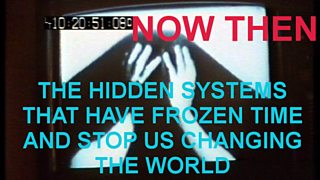
If you are an American politician today, as well as an entourage you also have a new, modern addition. You have what's called a "digital tracker". They follow you everywhere with a high-definition video camera, and they are employed by the people who want to destroy your political career.
It's called "opposition research" and the aim is to constantly record everything you say and do. The files are sent back every night to large anonymous offices in Washington where dozens of researchers systematically compare everything you said today with what you said in the past.
They are looking for contradictions. And if they find one - they feed it, and the video evidence, to the media.
On one hand it's old politics - digging up the dirt on your opponent. But it is also part of something new - and much bigger than just politics. Throughout the western world new systems have risen up whose job is to constantly record and monitor the present - and then compare that to the recorded past. The aim is to discover patterns, coincidences and correlations, and from that find ways of stopping change. Keeping things the same.
We can't properly see what is happening because these systems are operating in very different areas - from consumerism, to the management of your own body, to predicting future crimes, and even trying to stabilise the global financial system - as well as in politics.
But taken together the cumulative effect is that of a giant refrigerator that freezes us, and those who govern us, into a state of immobility, perpetually repeating the past and terrified of change and the future.

To bring this system into focus I want to tell the history of its rise, and its strange roots - the bastard love-child of snooping and high-level mathematical theory.
It begins with the grubby figure of the early 1960s in Britain - the Private Detective. Up till then private detectives mostly did divorce work. They would burst into hotel rooms to find a married person engaged in adulterous activity. Often these were prearranged situations, set up to supply the necessary evidence to get round Britain's tough divorce laws.
Then two things happened. The divorce laws were reformed - which meant the bottom fell out of the market. But at the same time home movie cameras became cheap and available. Private detectives began to spend their time hiding round corners and behind bushes - recording what their suspects got up to.
Here are two clips I've put together. The first is one of the old-school private detectives going to a hotel room in Brighton to "surprise" the occupants. Followed by a wonderful item from 1973 where one of the new breed shows how he can film people without them noticing. Or so he says. From the evidence you'd doubt it.
He mostly works for the insurance companies - following people and filming them to see if they are faking an injury they are claiming for. I love the 8mm cameras he uses.
The item also includes an interview with a man who is opposed to this snooping. The interviewer says surely they are just trying to find the truth - that a film can't lie. The man's response is great:
"A film can lie very easily - the insurance company or the investigator can edit the film. Supposing someone has a bad limp that only occurs on wet days, or it's a nervous spasm that comes on some days rather than others. The film is shown in court - and shows only the good days when there's no limp"
It's wonderfully silly - but he has a point. Bit like documentary films.
Then - in the early 1970s - the private detectives found they could buy another kind of technology really cheaply.
Bugging equipment.
A new business grew up - often based in tiny rooms above electronic hardware shops in central London. An odd collection of electrical engineers and refugees from the music industry spent their days soldering together miniature transmitters and microphones - and selling them to the private investigators.

Here's a really good film made about this new world in 1973. It not only reports on what is happening - but also catches the essence of what was coming. Most of the film is just set in one room where there are three hidden bugs as well as the normal camera and microphone recording the presenter who is called Linda Blandford. But she doesn't know where they are.
The film evokes the strange repetitive nature of an enclosed world where everything is recorded and played back. Way ahead of its time. It's a smart bit of reporting.
But then - at the end of the 1970s - people began to get worried. It began with revelations that the security agencies were eavesdropping not just on enemy spies but on their own people. Trades unions, radical journalists, politicians had all had their phones bugged.
It quickly spread to a wider concern about all the snooping and bugging that was going on, not just by the state but by private investigators, and by journalists. It was the start of the concern that Britain was becoming a "surveillance society".
Here is a bit report from that time about the growing fears. By now the private detective had become a man in a phone box blowing a harmonic whistle into the mouthpiece.
Journalists also started to get keen on all this new technology. It allowed them to snoop and listen to people in new ways. Here is great section from a fly-on-the wall documentary made about the News of the World in 1981.
There's a wonderful assistant editor who is convinced that Special Branch is bugging his phone. While reporter David Potts is testing his bugging equipment that's going to be used by Tina the junior reporter to expose a child sex ring in North London.
What then happens to Mr Potts' scoop is very funny. And it shows how difficult it was back then to bug someone. It's obvious that what they needed to find was an easier way of snooping on peoples' lives.
In 1987 the growing paranoia finally burst out. The trigger was a BBC television series called The Secret Society made by an investigative journalist called Duncan Campbell.
In 6 half-hour films Campbell pulled what had been happening all together - and drew a frightening picture that still haunts the imagination of the liberal left.
Not only were the security services and the police secretly watching and listening to you - but dark elements of the "security state" had a corrupt relationship with the private security world. The films showed how investigators could easily buy confidential information on anyone.
And at the same time other secret bureaucracies were building giant listening networks - and keeping them hidden from politicians. One of the episodes was about the plans to launch a spy satellite called Zircon. Campbell revealed that the project had been kept hidden from the very politicians who were supposed to oversee it.
The government and the head of GCHQ panicked and put enormous pressure on the BBC, who caved in and said they wouldn't transmit the episode. It was an enormous scandal - and it seemed to prove dramatically everything that Campbell was saying about the secret state who watched you - but didn't want you to know things.
Here are some extracts from the series. In one bit Campbell reveals how, as well as the state, the private sector have developed huge computer databases full of information about millions of ordinary people. In a great sequence he goes to a market in Knaresborough in Yorkshire and asks people if they'd like to see what these databases know about them.
Their reactions of horror to what they are shown are so innocent. It's like a lost world.
I've also included a brief bit from the Zircon film - so you can see what all the fuss was about. It didn’t remain banned for long - and has been shown since.
Looking back you can see how programmes like the Secret Society were part of the growing distrust of those who governed us. They seemed to prove that there were hidden, unaccountable and corrupt forces at the heart of the British state.
And the paranoia about surveillance carried on growing.
But at the very time as this happened - a new system of watching and monitoring people rose up. It would do pretty much what the spies and the private detectives had been trying to do - but much much more. It would record not just all our actions - but also be able to understand what was going on inside our heads - our wishes, our desires and our dislikes.
It was called the internet.
The problem was that the only way for the systems on the internet to work would be with our willing collusion. But rather than reject it - we all embraced it. And it flourished.
The key to why this happened lies in an odd experiment carried out in a computer laboratory in California in 1966.
A computer scientist called Joseph Weizenbaum was researching Artificial Intelligence. The idea was that computers could be taught to think - and become like human beings. Here is a picture of Mr Weizenbaum.
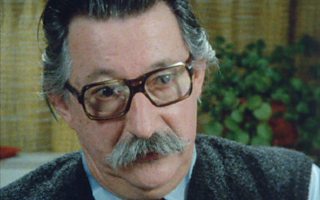
There were lots of enthusiasts in the Artificial Intelligence world at that time. They dreamt about creating a new kind of techno-human hybrid world - where computers could interact with human beings and respond to their needs and desires.
Weizenbaum though was sceptical about this. And in 1966 he built an intelligent computer system that he called ELIZA. It was, he said, a computer psychotherapist who could listen to your feelings and respond - just as a therapist did.
But what he did was model ELIZA on a real psychotherapist called Carl Rogers who was famous for simply repeating back the the patient what they had just said. And that is what ELIZA did. You sat in front of a screen and typed in what you were feeling or thinking - and the programme simply repeated what you had written back to you - often in the form of a question.
Weizenbaum's aim was to parody the whole idea of AI - by showing the simplification of interaction that was necessary for a machine to "think". But when he started to let people use ELIZA he discovered something very strange that he had not predicted at all.
Here is a bit from a documentary where Weizenbaum describes what happened.
Weizenbaum found his secretary was not unusual. He was stunned - he wrote - to discover that his students and others all became completely engrossed in the programme. They knew exactly how it worked - that really they were just talking to themselves. But they would sit there for hours telling the machine all about their lives and their inner feelings - sometimes revealing incredibly personal details.
His response was to get very gloomy about the whole idea of machines and people. Weizenbaum wrote a book in the 1970s that said that the only way you were going to get a world of thinking machines was not by making computers become like humans. Instead you would have to do the opposite - somehow persuade humans to simplify themselves, and become more like machines.
But others argued that, in the age of the self, what Weizenbaum had invented was a new kind of mirror for people to explore their inner world. A space where individuals could liberate themselves and explore their feelings without the patronising elitism and fallibility of traditional authority figures.
When a journalist asked a computer engineer what he thought about having therapy from a machine. He said in a way it was better because -
"after all, the computer doesn't burn out, look down on you, or try to have sex with you"
ELIZA became very popular and lots of researchers at MIT had it on their computers. One night a lecturer called Mr Bobrow left ELIZA running. The next morning the vice president of a sales firm who was working with MIT sat down at the computer. He thought he could use it to contact the lecturer at home - and he started to type into it.
In reality he was talking to Eliza - but he didn't realise it.
This is the conversation that followed.
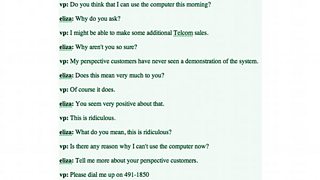
But, of course, ELIZA didn't ring him. The Vice President sat there fuming - and then decided to ring the lecturer himself. And this is the response he got:
Vice President - “Why are you being so snotty to me?”
Mr Bobrow - “What do you mean I am being snotty to you?”
Out of ELIZA and lots of other programmes like it came an idea. That computers could monitor what human beings did and said - and then analyse that data intelligently. If they did this they could respond by predicting what that human being should then do, or what they might want.
They key to making it work was a system called Boolean Logic.
It had been invented back in 1847 by a mathematician called George Boole. One day he'd been walking across a field near Doncaster when he had what he described as a "mystical experience". Boole said that he felt he had been "called on to express the workings of the human mind in symbolic or mathematical form".
Boole's idea was that everything that went on in the human mind could be reduced to a series of yes or no decisions that could be written out on paper using symbols.
His idea was pretty much ignored for over a hundred years - except by Lewis Carroll who as well as writing Alice in Wonderland, wrote a book called Symbolic Logic - that laid out and developed Boole's ideas.
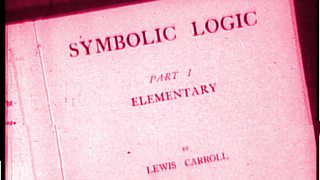
But when computers were invented people immediately realised that Boole's idea could be used to allow the computers to "think" in a reasoned way. Computers were digital - they were either 0 or 1 - and that was the same as "yes" and "no". So Boolean Logic became central to the way computers work today. They are full of endless decision trees saying "if this happened then this, and not this".
Here is a picture of George Boole taken in 1864. It was just before he died and it is one of the earliest portrait photos - he'd stopped off at the new London School of Photography at 174 Regent Street.

In the early 1990s researchers became convinced they could get computers to predict what people might want.
It started in 1992 with a small unit set up in the University of Minnesota. They called themselves GroupLens. Their idea was that if you could collect information on what people liked and then compare the data, you would find patterns - and from that you could make predictions.
They called it "Collaborative Filtering" - and the logic was beautifully Boolean. As one researcher put it -
"If Jack loves A and B and Jill loves A, B, and C then Jack is more likely to love C."
They began by comparing the news articles that people recommended in online newsgroups-
"GroupLens monitored user ratings of news articles. After a user had rated several items GroupLens was able to make recommendations about other articles the user might like. The results were astounding. Users read articles that we recommended highly three to four times as often as those we didn't"
Then, in 1994, a young professor at MIT did the same with music. She was called Pattie Maes - and she designed a system called RINGO. She set up a website where people listed songs and bands they liked. One user described how it worked
"What Ringo did was give you 20 or so music titles by name, then asked one by one whether you liked it, didn't like it, or knew it at all. That initialized the system with a small DNA of your likes and dislikes. Thereafter, when you asked for a recommendation, the program matched your DNA with that of all the others in the system. If some of the matches were not successful - saying so would perfect your string of bits. Next time would be even better"
Again it worked amazingly well. And Maes started to do the same with movies. Then the University of Minnesota group had a brainwave. If these systems could tell you what articles and songs you would like - why couldn't they tell you what products you would like as well?
So in 1997 they set up a company called Net Perceptions. And one of their first clients was Amazon.
But one of Amazon's young software engineers called Greg Linden soon realised that there was a problem with these systems. You had to spend all your time finding out what people said they liked. And as the systems became bigger and bigger - this was proving incredibly cumbersome.
Plus - people were fickle and they changed their mind a lot. Or - in computer engineer speak - they were "dynamic".
Linden saw what the solution was. You give up finding out what people said they liked and instead you just look at what they've done in the past. You assembled all the data from people's history - all the stuff they've looked at and bought in the past - and then compared that with other peoples' past.
Out of that came patterns and correlations that the human brain could not possibly see - but from those correlations you could tell what individuals would want in the future.
Linden was part of what was called The Personalization Group in Amazon. He said:
"the joke in the group was that if the system were working perfectly, Amazon should just show you one book - which is the next book you are going to buy."
And it worked - sales soared, and Jeff Bezos who runs Amazon allegedly crawled up to Linden on his hands and knees saying "I am not worthy".

What Amazon and many other companies began to do in the late 1990s was build up a giant world of the past on their computer servers. A historical universe that is constantly mined to find new ways of giving back to you today what you liked yesterday - with variations.
Interestingly, one of the first people to criticise these kind of “recommender systems” for their unintended effect on society was Patti Maes who had invented RINGO. She said that the inevitable effect is to narrow and simplify your experience - leading people to get stuck in a static, ever-narrowing version of themselves.
Stuck in the endless you-loop. Just like with ELIZA
But like so much of the modern digital world - these new systems are very abstract. And there is little to see that happens apart from endless fingers on keyboards. So it's difficult to bring these effects into any kind of real focus.
Last year - in a live show I did with Massive Attack - we tried to evoke this new world. We used a song from the 1980s called "Bela Lugosi's dead" - which I love because it has a very powerful feel of repetition. The audience were surrounded by 11 twenty-five foot high screens.
I'm not sure how successfully we did it - but what I was trying to show is how your past is continually being replayed back to you - like a modern ghost. And it means we stand still unable to move forwards. Like a story that's got stuck.
I’ve put a short bit of it together from some camera-phone videos shot by the audience in New York. It’s a bit rough - as is the sound - but you’ll get a sense of it.
For all the online companies that use these systems, the fact that they tend to inhibit change is an unintended consequence.
But there are other - more powerful systems that grew up in the 1990s whose explicit aim is exactly that. To prevent the world from changing, and hold it stable.
And they operate in exactly the same way - by constantly monitoring the world and then searching their vast databases for patterns and correlations.
ALADDIN is the name of an incredibly powerful computer network that is based in a tiny town called East Wenatchee - it's in the middle of nowhere in Washington State in North America.
Aladdin guides the investment of over $11 trillion of assets around the world.
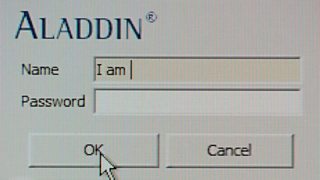
This makes it incredibly powerful. Aladdin is owned by a company called Blackrock that is the biggest investor in the world. It manages as much money as all the hedge-funds and the private equity firms in the world put together. And its computer watches over 7% of all the investments in the world.
This is unprecedented - it's a kind of power never seen before. But Blackrock is not run by a greedy, rapacious financier - the traditional figure of recent journalism. Blackrock is run by the very opposite - a very cautious man called Mr Fink
Here he is. He's called Larry Fink
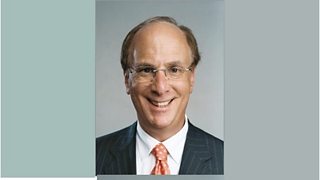
Back in 1986 Mr Fink was working his way up the First National Bank of Boston when an unpredicted fall in interest rates caused a disaster for the bank. He swore that it would never happen again - and for 20 years he built Aladdin.
It has within its memory a vast history of the past 50 years - not just financial - but all kinds of events. What it does is constantly take things that happen in the present day and compares them to events in the past. Out of the millions and millions of correlations - Aladdin then spots possible disasters - possible futures - and moves the investments to avoid that future happening.
I can't over-emphasise how powerful Blackrock's system is in shaping the world - it's more powerful in some respects than traditional politics.
And it raises really important questions. Because its aim is to not change the world - but to keep it stable. Preventing any development thats too risky. And when you are moving $11 trillion around to do that -it is a really important new force.
But it's boring. And there is no story. Just patterns.
Here is some video of Aladdin. A few weeks ago I was filming in Idaho - and decided to go and have a look at the buildings that house Aladdin. I had asked Blackrock if I could have a look inside. Surprisingly the guy in charge of their PR said yes. But a little while later he left the company in what seemed to be a reorganisation.
But it didn't really matter - because you know what it will look like. Row upon row of servers roaring away, and surrounded by giant batteries that will rescue the system if the power supply goes.
Here's the shot from the car driving past the computer sheds that house Aladdin. A 37 seconds tracking shot, and you can see how dull it is.
It is the modern world of power - and it's incredibly boring. Nothing to film, run by a cautious man who is in no way a wolf of Wall Street. It's how power works today. It hides in plain sight - through sheer boringness and dullness.
No wonder we find it difficult to tell stories about it.
There are also a growing number of systems that use data from the past to predict whether individuals are going to commit crimes in the future.
On the surface it's laudable. But it's also rather weird - and in some cases can be false and dangerous.
In every case the systems monitor individuals' behaviour and then sees if that shares similar characteristics with groups of other people stored on the databases who have behaved dangerously in the past.
There is software being used by the Department of Work and Pensions that detects fraudsters by analysing the voices of people who ring its call centres. If you ask the wrong kind of questions - or even ask the right kind of questions in the wrong way - it puts you in the dangerous group.
The government also has what they call a Social Exclusion unit which has an Action Plan. It's aim is to use data to predict when things might go wrong in poor families - even before birth. In one scheme the unborn child of a pregnant mother might be categorised as potentially being a future criminal.
This is based on things like the mother's age, her poor educational achievements, her drug use and her own family history. If the system decides that the unborn child is a potentially dangerous criminal the response is not exactly Philip K Dick - a nurse is sent round to give advice on parenting.
But the oddest is STATIC-99. It's a way of predicting whether sex offenders are likely to commit crimes again after they have been released. In America this is being used to decide whether to keep them in jail even after they have served their full sentence.
STATIC-99 works by scoring individuals on criteria such as age, number of sex-crimes and sex of the victim. These are then fed into a database that shows recidivism rates of groups of sex-offenders in the past with similar characteristics. The judge is then told how likely it is - in percentage terms - that the offender will do it again.
The problem is that it is not true. What the judge is really being told is the likely percentage of people in the group who will re-offend. There is no way the system can predict what an individual will do. A recent very critical report of such systems said that the margin of error for individuals could be as great as between 5% and 95%
In other words completely useless. Yet people are being kept in prison on the basis that such a system predicts they might do something bad in the future.

Opposition Research - the constant recording of everything a politician says and does fits into the same pattern.
But it's a system of wonk-driven surveillance that goes even further - because it has the unforeseen consequence of forcing politicians to behave like machines. It leads them to constantly repeat what they said yesterday, and unable to make imaginative or creative leaps
Every night the digital tracker sends back what that politician said or did today. The first aim is to find something outrageous in that day's video that can be given to the media.
Here is one classic example. It is Jon Bruning who compared welfare recipients to racoons. His speech up to that point is actually quite a funny right-wing attack on what he sees as the absurdity of environmental protection. But then he went too far.
And he was shamed. And he lost the election.
But the other - bigger - task of the opposition researchers is to spend hours comparing what the politician said today with their recorded past that is stored in the computers. They look for contradictions and if they find one they release the videos to the media and again the politician is shamed.
So the politicians become frozen and immobile - because they have to have a blameless history. Which again seems laudable. But it means they can't change their mind. They can't adapt to the world as it changes.
Although if ALADDIN has its way that won't matter
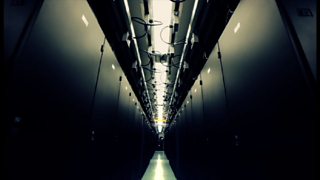
George Boole - who helped start all this with his Boolean Logic had an extraordinary family.
One of them, his son-in-law was called Charles Howard Hinton. He too was a mathematician and he became famous at the end of the nineteenth century when he wrote a book called The Fourth Dimension.
It said that time was an illusion. That everything that has happened and that will happen already exists in a four-dimensional space. Human beings, Hinton said, don't realise this because they don't have the ability to see this four-dimensional world.
Our idea of time - Hinton said - is just a line that goes across this four-dimensional space like a cross section. But we can't see it.
The cumulative effect of all today's systems that store up data from the past is to create something rather like Hinton's world. Everything that has already happened is increasingly stored on the giant servers in places like East Wenatchee.
It never goes away. And this past bears down on the present - continually being replayed to try and avoid anything that is dangerous and unpredictable.
What is missing is the other half of Hinton's world. The future - with all its dangers, but also all it's possibilities.
But George Boole had another daughter called Ethel. She had an amazing life - which showed that there is another way. Because Ethel believed in the future.
Here she is in a Boole family photo - taken after her father died. Ethel is to her mother’s right. (Incidentally the rest of the Boole family that you see in this photo also had amazing lives - but that’s another story)
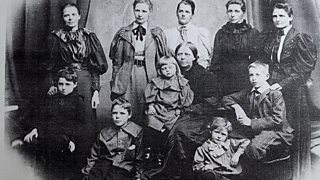
When Ethel was 15 she read a book about the Italian revolutionary Mazzini. It inspired her - and she wore clothes like him, dressing in black in mourning for the state of the world.
In 1889 she met a Polish revolutionary called Wilfred Michail Voynich. He had escaped from Siberia and had arrived penniless in London. They fell in love and married, and Ethel went off to Russia to smuggle in illegal revolutionary publications.
Then she met the master-spy Sydney Reilly. He is one of the most extraordinary figures in the odd world of espionage. He'd been born in the Ukraine, but turned against his family and faked his own suicide to escape.
After all kinds of adventures, including rescuing three British intelligence agents from the swamps of the Amazon jungles, Reilly went to London where he spent his time gambling - and he and Ethel began a passionate affair. They eloped to Italy where Reilly bared his soul to Ethel - telling her the extraordinary story of his life.
Then Reilly deserted her - and went off to Russia where he worked as a secret agent for the British. Ian Fleming is said to have used Reilly as the model for James Bond.
Ethel was heartbroken - and she wrote a novel called The Gadfly which, although she never admitted it, her biographer says is obviously based on the early adventures of Sydney Reilly.
It's the most amazing book. It's an over the top melodrama set in Italy about the hero, Arthur's battle against the church and the corrupt state - and his treacherous family. At the same time it is about his passionate love for an english girl - Gemma. It ends with Arthur being slowly tortured and then condemned to be shot.
Its message though is a revolutionary one. Arthur is sacrificed so that humankind can be redeemed and open the way to a realisation of the future possibilities for the world - once the old oppressive forces have been overthrown.
Here is Ethel with a wonderful revolutionary look in her eyes

The Gadfly was published in 1897 in New York - under Ethel's married name, E.L. Voynich. No British publisher would touch it because of its "outrageous and horrible character". But then it was published in Russia and became an astonishing success. One writer describes how all the young Bolsheviks read it and "it virtually became the bible of the revolution".
By the 1960s it was estimated that 250 million Russian teenagers had read the Gadfly in translation. And polls showed that Arthur was consistently the favourite hero of Soviet youth. And in 1955 a film version was made - with a soundtrack by Shostakovich - which won an award at the Cannes film festival.
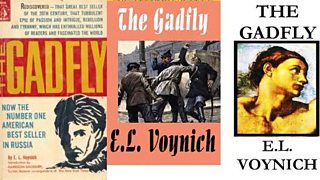
In 1920 Ethel went back to her husband Wilfred Voynich. He had moved to New York and had become one of the world's greatest expert and dealers in rare books.
His most famous purchase was a mysterious manuscript written in code that has come to be known as The Voynich Manuscript. No one has ever been able to break the code - it seems to have many scientific references, and herbal and astronomical illustrations.
Voynich believed that it was written by the philosopher Roger Bacon - and then came into the possession of the legendary John Dee who was a mathematician at the court of Queen Elizabeth.
After Voynich died, Ethel kept the manuscript in a safe deposit box in New York for thirty years - and then sold it in 1960. And it ended up in Yale University. One of the great experts in cryptography wrote:
"The Voynich manuscript lies quietly inside its slipcase in the blackness of Yale's vaults, possibly a time-bomb in the history of science, awaiting the man who can interpret what is still the most mysterious manuscript in the world."

Ethel Boole died in 1960 at the age of 96. Still believing in the power of revolution to change the world. Here is one of the most beautiful sections of Shostakovich's music for the Gadfly - cut to images of the strange Boolean world that we live in today.
